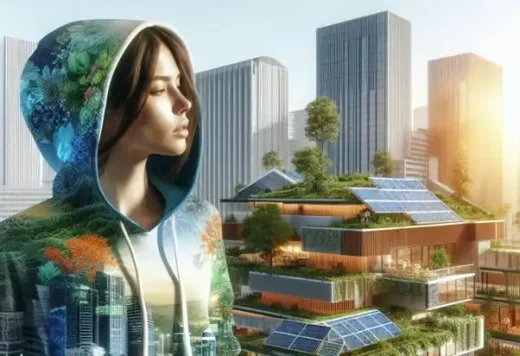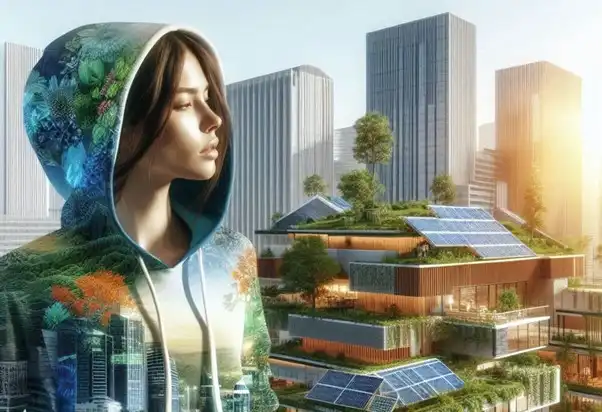Exploring the aesthetics of materials, Building design to wearable art, Fashion designers textiles
Exploring the Aesthetics of Materials: From Building Design to Wearable Art
28 August 2024

Image created with Microsoft Designer
Material innovation shapes our world in fascinating ways. You see it in the buildings that inspire and the clothes that define personal style. Architects push boundaries with sustainable materials, creating stunning structures. Fashion designers mirror this trend, crafting unique pieces from textiles designed for impact.
Join me as we explore how these aesthetics intertwine. We’ll uncover practical examples and insights into choosing materials that not only look good but also make a statement. Get ready to see creativity from fresh angles!
The Role of Sustainable Materials in Modern Architecture
Architects are pioneering new paths with eco-conscious materials, revolutionizing contemporary design aesthetics. There’s a burgeoning trend within the industry towards materials like reclaimed wood, bamboo, and recycled metal – choices that diminish our ecological footprint.
These selections surpass mere visual appeal; they amplify energy efficiency and foster healthful environments.
Developments such as rooftop solar arrays or systems for collecting rainwater signal an escalating dedication to sustainability. Utilizing green materials bridges the gap between edifices and their natural environments without compromising on longevity.
By embracing these practices, architects push the boundaries of creativity and responsibility. They forge buildings that resonate with both beauty and purpose, encouraging communities to rethink their connection with nature as we build for the future.
Textiles That Transform: Innovations in Fashion Design
Innovative textiles are revolutionizing fashion design, leading to creative expressions that mirror architectural trends. Designers now experiment with materials that boast functionality and aesthetic appeal. High-performance fabrics respond to urban lifestyles, ensuring comfort without sacrificing style.
Custom hoodies stand out as versatile urban wearables, blending seamlessly with the dynamic environment shaped by modern architecture. Companies like Printful enable individuals to create personalized pieces that reflect their unique styles while maintaining practicality.
This trend highlights a deeper connection between what we wear and our surroundings. As fashion adapts to new technologies and sustainable practices, the possibilities for transformation become endless, making everyday attire a canvas for creativity.
Bridging Urban Wear and Architectural Aesthetics
Urban wear and architectural aesthetics share a unique relationship, where style meets functionality. Designers draw inspiration from the clean lines and innovative structures of modern buildings to create apparel that resonates with city life.
This synergy often results in clothing that embraces minimalist designs, durable materials, and versatile styles suitable for various settings. Custom hoodies exemplify this connection by providing comfort while complementing the urban landscape.
The emphasis on quality craftsmanship reflects a broader trend toward sustainability in architecture and fashion. As consumers seek out pieces that resonate with their environment, this fusion fosters an appreciation for thoughtful design in our daily lives.
The Impact of Color and Texture on Material Selection
Color and texture significantly influence material selection in both architecture and fashion. Designers consider these elements to create visually appealing and cohesive designs. Key factors include:
- Emotional Resonance: Different colors stir different feelings. Vibrant reds and oranges may invigorate an area, whereas cool shades are known to induce tranquility.
- Tactile Diversity: The interplay between sleek surfaces and coarse textures lends complexity, seizing the gaze with inviting visual layers.
- Natural Synchronization: Opting for color palettes that echo the environment ensures seamless integration of structures or apparel within a given locale.
These choices not only enhance aesthetic appeal but also serve functional purposes. Thoughtful color palettes and textural combinations help designers communicate messages through materials while elevating user experiences in everyday life.
Adaptive Reuse: Breathing New Life into Old Structures
Adaptive reuse breathes new life into old structures, merging the past with modern design principles. This practice elevates sustainability, favoring the reimagining of standing structures over demolition. Architects masterfully reshape environments while safeguarding heritage features, forging an exceptional amalgamation of tradition and innovation.
Cutting-edge methods guarantee these refreshed buildings cater to modern-day requisites without sacrificing their distinct personality. The integration of sustainable resources and energy-conserving systems heightens both utility and ecological considerations.
As urban landscapes evolve, adaptive reuse stands out as a vital strategy that promotes preservation while embracing innovation. It reflects a growing awareness of resourcefulness in design, reminding us to cherish history while building for the future.
Embracing Sustainable Innovation in Design
Sustainable innovation drives the future of design across architecture and fashion. By prioritizing eco-friendly materials and practices, creators forge connections between style and responsibility.
This shift not only enhances aesthetics but also fosters a deeper appreciation for our environment. As we move forward, integrating sustainability into design will shape a more conscious approach to building and personal expression.
Comments on this guide to Exploring the aesthetics of materials: from building design to wearable art article are welcome.
New Buildings
Building Designs – architectural selection below:
Building Articles
Residential Architecture
Comments / photos for the Exploring the aesthetics of materials: from building design to wearable art page welcome.





